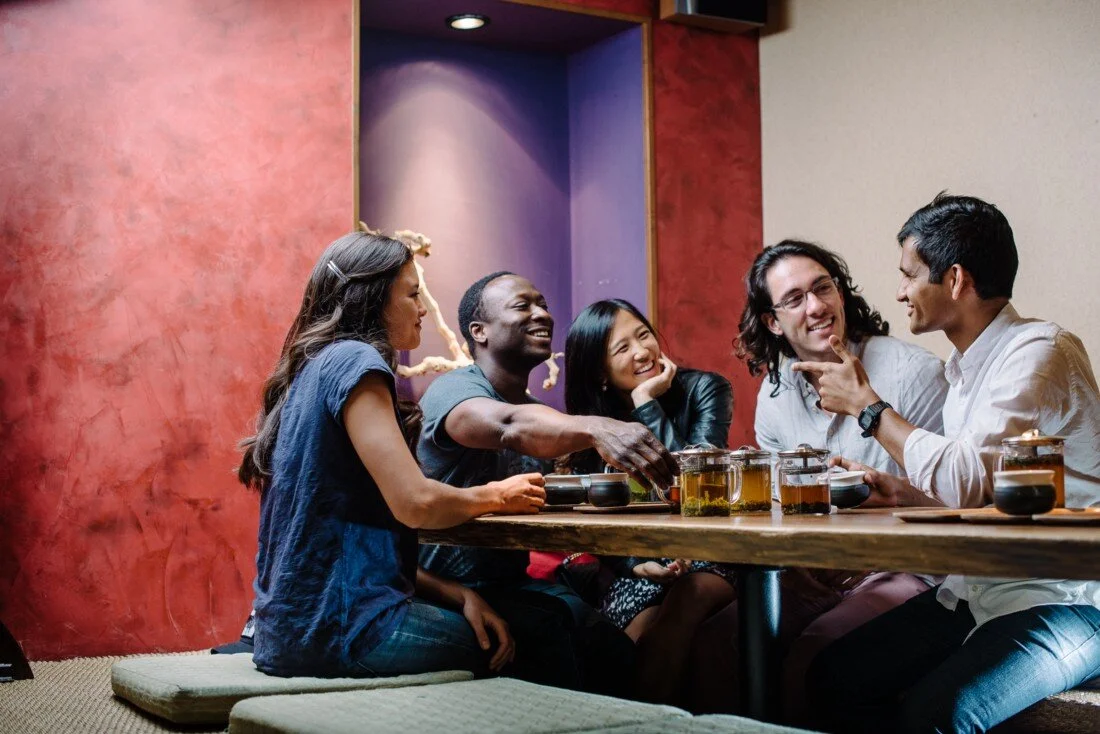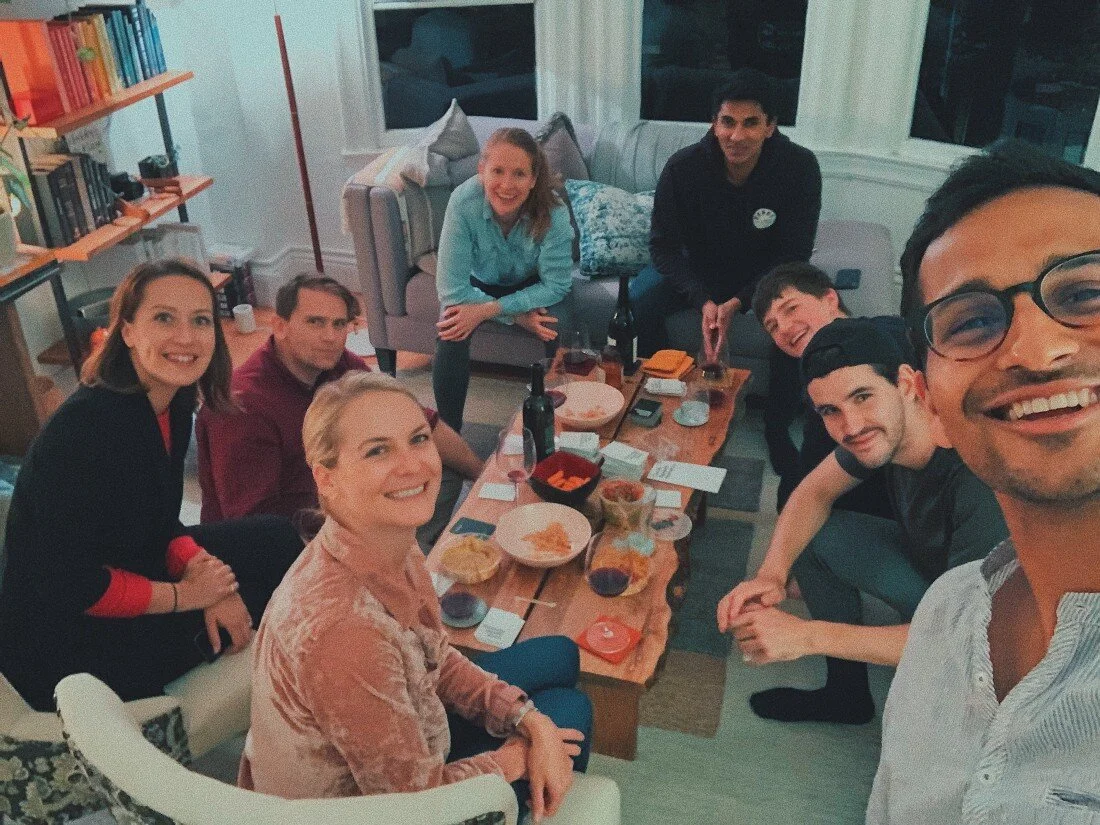What a little "social courage" can do: Connecting strangers through tea time 🍵 Ankit Shah, Tea With Strangers
Listen on: Apple, Google, Spotify, Stitcher, TuneIn, Overcast, Pocketcast, RSS
Read: Transcript
Episode at a glance:
GUEST: Ankit Shah
COMMUNITY: Tea with Strangers
HOSTS: Maggie Zhang & Bailey Richardson
“If you're going to lead an organization, it's likely that more of your time and energy is going into building an engine and less of your time and energy is going into facilitating connection between people. It's really important for community leaders to recognize if they want to lead an organization or if they want to facilitate connection.” -- Ankit Shah
Show Notes
Motivated by a sense of nostalgia during his senior year of college, Ankit Shah posted an open call: he wanted to get tea with anyone on campus who he hadn’t met before. To his surprise, 250 University of Pennsylvania students said “yes” and he found himself spending the last 6 weeks of college meeting with six new people for three hours every night in the same cafe.
He realized that strangers were excited to meet and learn about each other beyond surface day-to-day interactions. After graduation, he founded an organization called Tea with Strangers, which paired strangers together for small group conversations. Since its founding in May 2014, it has brought over 50,000 people in 25 cities together.
Today, Ankit has brought this community-first mindset to his work at Facebook and Airbnb, and also to his personal life, creating Silent Hike Society and weekly neighborhood gatherings.
Silent Hike Society
Neighborhood gathering in Ankit’s San Francisco neighborhood.
In this episode, we learned about how Ankit grew a global community of hosts for Tea with Strangers, how he translated his learnings into a career and the value of alone time as a community-builder.
Bonus! Popcorn Q&A with Ankit
As a supplement to our podcast interview, we hosted an AMA-style conversation with Ankit on Substack. Read the full thread here.
When you first started Tea With Strangers, was it tough and disheartening at first?
Ankit: When I first started Tea With Strangers, it was a personal project (it’s still online here!). I asked my friends to tell their friends who lived in SF about it. It pretty quickly spread amongst a lot of my friends of friends, and within 6 months, I had about 1,500 people signed up on the website and had tea with about 600–700 people in groups of 6 at a time.
I picked cafés and parks to host all the conversations, which is still the case today (well, asides from COVID). It was definitely awkward at first, but I don’t think it was tough or disheartening in any way. I didn’t come into the project with very many expectations, so anything that happened was amazing as far as I was concerned. (This was 7 years ago. Honestly, one of my greatest wishes is to hold onto this sort of bright-eyed-ness as I continue to grow as a community building).
When you bring together strangers in a forum like Tea with Strangers, do you have intention around how you navigate charged political topics?
Ankit: My intention with Tea With Strangers (TWS) is to create spaces that center around what we share over what we differ on. I think the nature of this invitation comes across pretty clearly throughout the journey of someone discovering TWS, signing up, receiving the automated emails, and the personalized pre-tea time emails that they receive from their host.
That said, the container of the conversation when people arrive at a cafe or park to meet with complete strangers is shaped significantly before anybody even arrives. Everyone responds differently to this container, of course, but the nature of the container is important because it provides a tonal anchor in the face of cynicism, assumptive behavior or any other byproduct of in-group polarization.
Tea with Strangers
That anchor, to be super explicit, is the positively rooted assumption that everyone is doing the best with the information they have in the moment that they are in.
Naturally, when a conversation starts with that, it’s unlikely that “fever pitched ideological arguments” surface all that often, but it still happens!
When it does, it usually grows out of someone picking at a thread that’s tangential to something else that’s being discussed. Some examples: any discussion that ventures into the realm of cancel culture, the impact of transplants on gentrification, differences in behavior or attitudes towards women or LGBTQIA+ people, etc.. Each and every one of these can spur a heated argument but starts with an often innocuous comment that’s picked at, taken out of context, and misinterpreted.
As a host of these conversations, when I notice these moments unfolding, it’s my job to register it and support the actual purpose of the conversation — to build understanding. It’s silly to try to stifle it and say, “Oh well we don’t have those conversations at Tea With Strangers, so let’s redirect.” That would leave an unresolved thread in the conversation and an obvious source of tension.
Instead, I try questions and reflections.
Examples:
To the person that said something that may have been misinterpreted: “I’m not sure I fully understood what you meant when you said X, can you say more?”
To a person that is getting heated and driving the conversation in a divisive direction: “I definitely have strong thoughts about this too, but I don’t think I’m super informed here. I’d love to better understand how you came to thinking what you think.”
To everybody else at the table sitting quietly: “Clearly, this is something that everybody has thoughts on. I’d love to hear what [person who has been quiet for a while] thinks.”
Of course, there’s a lot of nuance and grace to be applied in the delivery here, which I’d approach differently on a case by case basis, but I think the core theme that I rely on is that people have reasons for feeling the way they do, for saying what they say, for approaching others the way they do. Instead of rejecting it, how can we defuse and create space to dig deeper, to learn about one another, and come out with a greater ability to truly see each other.
You talked a lot about offline, in-person communities in your podcast episode.
How do you think the Internet and social media can play a role in fostering human connections + meaningful interaction?
Ankit: If it’s not obvious, I’m very optimistic around the potential of the internet and social media in fostering greater, more meaningful connection.
There is, of course, a lot to be delved into around the dark side of the internet, the ways in which it can have an impact on making the web of our society more brittle, and inspire us to assume the worst of one another — and this is something I could speak to in another conversation, but I digress.
I think when you consider the internet on an individual basis (i.e. your specific experience of it), each of us has so much agency and power to deepen our relationships with the assistance of the internet.
Ankit hosting an offline neighborhood gathering in his San Francisco neighborhood.
One way that I think about this by framing social media as the best tool to *invite* meaningful interactions — instead of being the best tool to *have* meaningful interactions. That said, I think the way we choose to show up on social media, the way we present ourselves, the things we choose to say, share, comment on, have opinions about, etc. is everything.
The highest leverage decision you can make around what your experience of the internet is is answering the question: Who am I presenting? What does this presentation invite?
A common mistake I think a lot of people make is thinking about who they present on the internet as who they ARE, but you are far too multitudinous to have your whole self presented on the internet. That’s a silly expectation.
A far more reasonable expectation is to present the version of yourself that welcomes the others. The others being people you don’t even know you need to connect with but will reveal themselves once you’ve revealed *yourself*.
Who do you look to for guidance and advice both in your inner circle and in the wider world?
Ankit: For advice: my girlfriend, the coffeeshop, nature, my sister, my closest friends, and whoever I’m talking to recently at the top of my text message inbox that I trust and feel comfortable enough sending an audio message to for advice.
For guidance and inspiration: I look to many, many sources, but I think what’s more valuable to consider here is a framework:
I think about my areas of interest, passion and perspective on the world and find people who fit these various categories and pay attention to what they say, what they do, and what they create. When paying attention, I don’t take anything too prescriptively, but I do reflect on what I would do if I were that person in whatever situation they find themselves in. This helps me develop a stronger muscle of consideration for myself, so I can better tune into the person I am choosing to be in any given decision moment I find myself in (big or small).
I think this helps me register guidance in a way that is personalized and meaningful to me.
As for who I specifically look to here, here’s a copy and paste from my Notes.app with areas of interest and people that I look up to and like to learn from. Some of these people are friends. Some are just people I follow. It’s not exhaustive (at all), ranked in any way whatsoever, and the taxonomy is probably not very good, but it works for me. Feel free to give all these people a google and follow them wherever they have an internet presence.
Kindness: Nipun Mehta. Birju Pandya. Chaz Howard.
Living: Leo Babauta. Tim Ferriss. Ramit Sethi. Alain de Botton. Krista Tippett. Casper ter Kuile.
Impact: Zubin Sharma. Vallabh Pandey. Jacqueline Novogratz. Craig Shapiro. Cameron Sinclair.
Design (Art): Tina Roth Eisenberg. Dave Radparvar. Jim Coudal. Max Tempkin. Jessica Walsh.
Design (Tech): Josh Miller. Sahil Lavingia. Kevin Huynh. Mike Monteiro.
Curiosity and knowledge: Joe Cohen. Maria Popova. Jason Kottke. Amit Gupta. Zach Klein. Charlie Kubal. Kevin Rose. Dani Grant. Kai Brach.
Seeing and Storytelling: Jason Polan. Marc Johns. Musa Tariq. Craig Mod. The Oatmeal. Brandon Stanton. Casey Neistat. Aziz. John Mulaney. Hannibal Burress. Simone Stolzoff. Jerry Seinfeld. Chris Bukard.
Business: Jason Fried. Patrick McKenzie. Dan Shipper. Nathan Baschez.
Marketing: Noah Kagan. Seth Godin.
Community: Scott Heiferman. Fabian Pfortmueller. Bailey Richardson. Chris Arnade. Serena Bian.
Thinking: Dan Shipper. BJ Fogg. Richard Thaler. Dan Kahnemahn. Ammar Mian. Tim Urban.
Do you ever worry about the perils of becoming “internet famous”? If so, how do you personally navigate that?
Ankit: I definitely think about it, but I also balance this concern with a concerted effort to not do or say anything I don’t mean. I try really hard to only share things with the internet that I truly feel and mean in my heart.
A lot of the time, this comes at the cost of engagement and virality, but to me, that’s a perfectly fine tradeoff if it means that the people I connect with on the internet are people that are truly invested in a connection. Invariably, what happens as a result is that the people that connect with me on the internet are generally bringing really positive intentions with them.
My tune on this might change if I become someone with 10s or 100s of thousands of followers on any platform, but I don’t know if that will happen.
This is something I could write a whole ‘nother essay about, honestly, so feel free to ask follow ups!
How do you think the way you deliver your message would change if your audience ballooned to include thousands of more people? Would you change your delivery?
Ankit: I really hope not.
Honestly, the biggest thing that would change might be the amount that I talk about myself (how meta is this?!), but even then, I feel deeply uncomfortable sharing something that I couldn’t look you in the eye IRL and stand by, so I’d hope that even the way I go about promoting things that I do would probably still be pretty straightforward and self-aware.
A reminder I think is important for myself: anybody behind an internet account is a person with a full life and a range of considerations, emotions, and experiences behind anything they share in the world. That includes me. It can often be easy to forget this truth when perceiving others, and I understand that. That said, how can I do everything in my expressive power to be as real of a person as I can?
Ankit’s TEDx Talk on Being Alone to an audience of people at Pine Crest School
How do you summon the confidence that is sharing your thoughts with the world?
Ankit: This is something I have really ebbed and flowed with over the last decade. I think I’m generally optimistic about what sharing thoughts with the world can introduce as far as serendipity goes. I never know exactly what will happen, but I truly believe that if what you share comes from the heart, only good things can happen — and the things that might seem bad are actually opportunities to dig into yourself.
In other words: at worst, you reflect and learn something about yourself. At best, you’ve put the tentacles of your mind and heart into the world — something anybody can jump in and connect with. Almost always, what happens is not something I could have expected.
What’s something amazing you’ve learned about yourself in the last year?
Photo of Ankit
Ankit: I don’t know what amazing means here (i.e. amazing to who? On what basis?), but here are two things that I’ve learned about myself that surprised me or made me think in new ways:
I can put someone else’s priorities ahead of my own and find that things turn out better than if I had put my own priorities first (individually, relationally, spiritually, and, in some cases, societally). This has made me wonder about the timeframe on which I consider my priorities, what it means to be values driven or to play a long game
When it comes to work and projects, I’ve grown more aware that my impact and influence is disproportionately high in just a few places, not everywhere. This has pushed me to think more critically about where I insert myself when it comes to any given mission or objective and to focus more on leverage than input.
Question of the day: What is your “go-to question” when getting to know strangers?
Ankit: My first impulse when I meet someone new is to notice something about that person that lights me up, even in some small way. Cool earrings, a hat, toenail colors, pants, sound of their voice, whatever. I generally try to highlight this thing in a way that is as not-awkward as possible.
To be clear: This isn’t a strategy or anything. It’s just something I’ve done for most of the last decade, and I guess it’s always opened up really beautiful interactions. I think it’s because things like this make people feel very seen, which makes it easier to get real, honest responses when I ask anything that I ask after that.
And usually, my go-to question is some simple permutation of: “What’s going on in your world?”
Other framings:
What’s been on your mind?
What should I know about you?
How have you been feeling lately?
This was our question of the day. See what other folks who tuned in had to say.
See the full thread of Q&A with Ankit here.
Get Together is produced by the team at People & Company.
We published a book and we’ve worked with organizations like Nike, Porsche, Substack and Surfrider as strategy partners, bringing confidence to how they’re building communities.
Stay up to date on all things Get Together.









